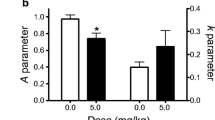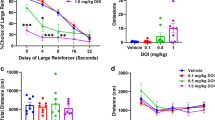Abstract
Rationale
Impulsive choice has often been evaluated in rodents according to the proportion of choices for the delayed large magnitude reinforcer (%large choice) in a delay-discounting task (DDT). However, because %large choice is influenced by both sensitivity to reinforcer magnitude and sensitivity to delayed reinforcement (i.e., discounting rate), distinctively evaluating such discounting parameters represents a critical issue demanding methods to determine each parameter in rats. The serotonin (5-HT) system is well known to be involved in impulsive choice; nevertheless, only a few studies have distinguished discounting parameters and investigated how 5-HT modulators affect discounting rate.
Objective
Here, we performed a discounting parameter analysis in mice and examined the effects of various 5-HT modulators on discounting rate.
Methods
We set up DDTs with different delay schedules to determine which schedule could address delay-discounting rates in mice. We examined the effect of the following drugs on impulsive choice: a 5-HT reuptake inhibitor (paroxetine), a 5-HT1A receptor agonist (8-OH-DPAT), and two 5-HT3 receptor antagonists (granisetron and ondansetron).
Results
Mice showed typical delay discounting at the shorter delay schedules (up to 4 s delay). The %large choice under shorter, but not longer, schedules followed an exponential function and allowed us to derive discounting rates. We selected a DDT with a 4-s delay schedule for further experiments. Granisetron and ondansetron, but not paroxetine or 8-OH-DPAT, decreased discounting rates without affecting sensitivity to reinforcer magnitude.
Conclusion
We found that a method to calculate discounting rates in rats is also applicable to mouse models. We also provided evidence that 5-HT3 antagonism controls impulsive choice in mice.






Similar content being viewed by others
References
Adriani W, Zoratto F, Romano E, Laviola G (2010) Cognitive impulsivity in animal models: role of response time and reinforcing rate in delay intolerance with two-choice operant tasks. Neuropharmacology 58:694–701
Ainslie G (1975) Specious reward: a behavioral theory of impulsiveness and impulse control. Psychol Bull 82:463–496
Ainslie G, Herrnstein RJ (1981) Preference reversal and delayed reinforcement. Anim Learn Behav 9:476–482
Artaiz I, Romero G, Zazpe A, Monge A, Caldero JM, Roca J, Lasheras B, Del Rio J (1995) The pharmacology of VA21B7: an atypical 5-HT3 receptor antagonist with anxiolytic-like properties in animal models. Psychopharmacology 117:137–148
Baarendse PJ, Vanderschuren LJ (2012) Dissociable effects of monoamine reuptake inhibitors on distinct forms of impulsive behavior in rats. Psychopharmacology 219:313–326
Betry C, Overstreet D, Haddjeri N, Pehrson AL, Bundgaard C, Sanchez C, Mork A (2015) A 5-HT3 receptor antagonist potentiates the behavioral, neurochemical and electrophysiological actions of an SSRI antidepressant. Pharmacol Biochem Behav 131:136–142
Bickel WK, Marsch LA (2001) Toward a behavioral economic understanding of drug dependence: delay discounting processes. Addiction 96:73–86
Blasio A, Narayan AR, Kaminski BJ, Steardo L, Sabino V, Cottone P (2012) A modified adjusting delay task to assess impulsive choice between isocaloric reinforcers in non-deprived male rats: effects of 5-HT(2)A/C and 5-HT(1)A receptor agonists. Psychopharmacology 219:377–386
Buhusi M, Olsen K, Buhusi CV (2017) Increased temporal discounting after chronic stress in CHL1-deficient mice is reversed by 5-HT2C agonist Ro 60-0175. Neuroscience 357:110–118
Buhusi M, Olsen K, Yang BZ, Buhusi CV (2016) Stress-induced executive dysfunction in GDNF-deficient mice, a mouse model of parkinsonism. Front Behav Neurosci 10:114
Chameau P, van Hooft JA (2006) Serotonin 5-HT(3) receptors in the central nervous system. Cell Tissue Res 326:573–581
Crockett MJ, Clark L, Lieberman MD, Tabibnia G, Robbins TW (2010) Impulsive choice and altruistic punishment are correlated and increase in tandem with serotonin depletion. Emotion 10:855–862
David DJ, Renard CE, Jolliet P, Hascoet M, Bourin M (2003) Antidepressant-like effects in various mice strains in the forced swimming test. Psychopharmacology 166:373–382
Dent CL, Humby T, Lewis K, Plagge A, Fischer-Colbrie R, Wilkins JF, Wilkinson LS, Isles AR (2016) Impulsive choices in mice lacking imprinted Nesp55. Genes Brain Behav 15:693–701
Epstein LH, Salvy SJ, Carr KA, Dearing KK, Bickel WK (2010) Food reinforcement, delay discounting and obesity. Physiol Behav 100:438–445
Evenden JL, Ryan CN (1996) The pharmacology of impulsive behaviour in rats: the effects of drugs on response choice with varying delays of reinforcement. Psychopharmacology 128:161–170
Evenden JL, Ryan CN (1999) The pharmacology of impulsive behaviour in rats VI: the effects of ethanol and selective serotonergic drugs on response choice with varying delays of reinforcement. Psychopharmacology 146:413–421
Green L, Myerson J, Lichtman D, Rosen S, Fry A (1996) Temporal discounting in choice between delayed rewards: the role of age and income. Psychol Aging 11:79–84
Isles AR, Hathway GJ, Humby T, de la Riva C, Kendrick KM, Wilkinson LS (2005) An mTph2 SNP gives rise to alterations in extracellular 5-HT levels, but not in performance on a delayed-reinforcement task. Eur J Neurosci 22:997–1000
Isles AR, Humby T, Walters E, Wilkinson LS (2004) Common genetic effects on variation in impulsivity and activity in mice. J Neurosci 24:6733–6740
Isles AR, Humby T, Wilkinson LS (2003) Measuring impulsivity in mice using a novel operant delayed reinforcement task: effects of behavioural manipulations and d-amphetamine. Psychopharmacology 170:376–382
Koffarnus MN, Woods JH (2013) Individual differences in discount rate are associated with demand for self-administered cocaine, but not sucrose. Addict Biol 18:8–18
Korte SM, Prins J, Van den Bergh FS, Oosting RS, Dupree R, Korte-Bouws GA, Westphal KG, Olivier B, Denys DA, Garland A, Gunturkun O (2017) The 5-HT1A/1B-receptor agonist eltoprazine increases both catecholamine release in the prefrontal cortex and dopamine release in the nucleus accumbens and decreases motivation for reward and “waiting” impulsivity, but increases “stopping” impulsivity. Eur J Pharmacol 794:257–269
Liu YP, Wilkinson LS, Robbins TW (2004) Effects of acute and chronic buspirone on impulsive choice and efflux of 5-HT and dopamine in hippocampus, nucleus accumbens and prefrontal cortex. Psychopharmacology 173:175–185
Madden GJ, Francisco MT, Brewer AT, Stein JS (2011) Delay discounting and gambling. Behav Process 87:43–49
Miyazaki KW, Miyazaki K, Doya K (2012) Activation of dorsal raphe serotonin neurons is necessary for waiting for delayed rewards. J Neurosci 32:10451–10457
Mobini S, Body S, Ho MY, Bradshaw CM, Szabadi E, Deakin JF, Anderson IM (2002) Effects of lesions of the orbitofrontal cortex on sensitivity to delayed and probabilistic reinforcement. Psychopharmacology 160:290–298
Mobini S, Chiang TJ, Ho MY, Bradshaw CM, Szabadi E (2000) Effects of central 5-hydroxytryptamine depletion on sensitivity to delayed and probabilistic reinforcement. Psychopharmacology 152:390–397
Morales M, Bloom FE (1997) The 5-HT3 receptor is present in different subpopulations of GABAergic neurons in the rat telencephalon. J Neurosci 17:3157–3167
Paterson NE, Wetzler C, Hackett A, Hanania T (2012) Impulsive action and impulsive choice are mediated by distinct neuropharmacological substrates in rat. Int J Neuropsychopharmacol 15:1473–1487
Patros CH, Alderson RM, Kasper LJ, Tarle SJ, Lea SE, Hudec KL (2016) Choice-impulsivity in children and adolescents with attention-deficit/hyperactivity disorder (ADHD): a meta-analytic review. Clin Psychol Rev 43:162–174
Porras G, De Deurwaerdère P, Moison D, Spampinato U (2003) Conditional involvement of striatal serotonin3receptors in the control of in vivo dopamine outflow in the rat striatum. Eur J Neurosci 17:771–781
Rudebeck PH, Walton ME, Smyth AN, Bannerman DM, Rushworth MF (2006) Separate neural pathways process different decision costs. Nat Neurosci 9:1161–1168
Schweighofer N, Bertin M, Shishida K, Okamoto Y, Tanaka SC, Yamawaki S, Doya K (2008) Low-serotonin levels increase delayed reward discounting in humans. J Neurosci 28:4528–4532
Sharif NA, Wong EH, Loury DN, Stefanich E, Michel AD, Eglen RM, Whiting RL (1991) Characteristics of 5-HT3 binding sites in NG108-15, NCB-20 neuroblastoma cells and rat cerebral cortex using [3H]-quipazine and [3H]-GR65630 binding. Br J Pharmacol 102:919–925
Stanis JJ, Burns RM, Sherrill LK, Gulley JM (2008) Disparate cocaine-induced locomotion as a predictor of choice behavior in rats trained in a delay-discounting task. Drug Alcohol Depend 98:54–62
Talpos JC, Wilkinson LS, Robbins TW (2006) A comparison of multiple 5-HT receptors in two tasks measuring impulsivity. J Psychopharmacol 20:47–58
Tecott LH, Maricq AV, Julius D (1993) Nervous system distribution of the serotonin 5-HT3 receptor mRNA. Proc Natl Acad Sci U S A 90:1430–1434
van den Bergh FS, Bloemarts E, Groenink L, Olivier B, Oosting RS (2006) Delay aversion: effects of 7-OH-DPAT, 5-HT1A/1B-receptor stimulation and D-cycloserine. Pharmacol Biochem Behav 85:736–743
Winstanley CA, Dalley JW, Theobald DEH, Robbins TW (2003) Global 5-HT depletion attenuates the ability of amphetamine to decrease impulsive choice on a delay-discounting task in rats. Psychopharmacology 170:320–331
Winstanley CA, Theobald DE, Dalley JW, Robbins TW (2005) Interactions between serotonin and dopamine in the control of impulsive choice in rats: therapeutic implications for impulse control disorders. Neuropsychopharmacology 30:669–682
Wogar MA, Bradshaw CM, Szabadi E (1993) Effect of lesions of the ascending 5-hydroxytryptaminergic pathways on choice between delayed reinforcers. Psychopharmacology 111:239–243
Wolff MC, Leander JD (2002) Selective serotonin reuptake inhibitors decrease impulsive behavior as measured by an adjusting delay procedure in the pigeon. Neuropsychopharmacology 27:421–429
Yates JR, Batten SR, Bardo MT, Beckmann JS (2015) Role of ionotropic glutamate receptors in delay and probability discounting in the rat. Psychopharmacology 232:1187–1196
Yates JR, Gunkel BT, Rogers KK, Hughes MN, Prior NA (2017a) Effects of N-methyl-D-aspartate receptor ligands on sensitivity to reinforcer magnitude and delayed reinforcement in a delay-discounting procedure. Psychopharmacology 234:461–473
Yates JR, Perry JL, Meyer AC, Gipson CD, Charnigo R, Bardo MT (2014) Role of medial prefrontal and orbitofrontal monoamine transporters and receptors in performance in an adjusting delay discounting procedure. Brain Res 1574:26–36
Yates JR, Rogers KK, Gunkel BT, Prior NA, Hughes MN, Sharpe SM, Campbell HL, Johnson AB, Keller MG, Breitenstein KA, Shults HN (2017b) Effects of group I metabotropic glutamate receptor antagonists on sensitivity to reinforcer magnitude and delayed reinforcement in a delay-discounting task in rats: contribution of delay presentation order. Behav Brain Res 322:29–33
Funding
This work was supported by Grant-in-Aid for Scientific Research (B) from MEXT to K.F.T. (15H03123), Grant-in-Aids for Scientific Research on Innovative Area “Willdynamics” (17H06062) and “Oscillology” (16H01621) from the MEXT to K.F.T.
Author information
Authors and Affiliations
Corresponding authors
Ethics declarations
Conflict of interest
The authors declare that they have no competing interests.
Electronic supplementary material
ESM 1
(DOCX 197 kb)
Rights and permissions
About this article
Cite this article
Mori, M., Tsutsui-Kimura, I., Mimura, M. et al. 5-HT3 antagonists decrease discounting rate without affecting sensitivity to reward magnitude in the delay discounting task in mice. Psychopharmacology 235, 2619–2629 (2018). https://doi.org/10.1007/s00213-018-4954-0
Received:
Accepted:
Published:
Issue Date:
DOI: https://doi.org/10.1007/s00213-018-4954-0




